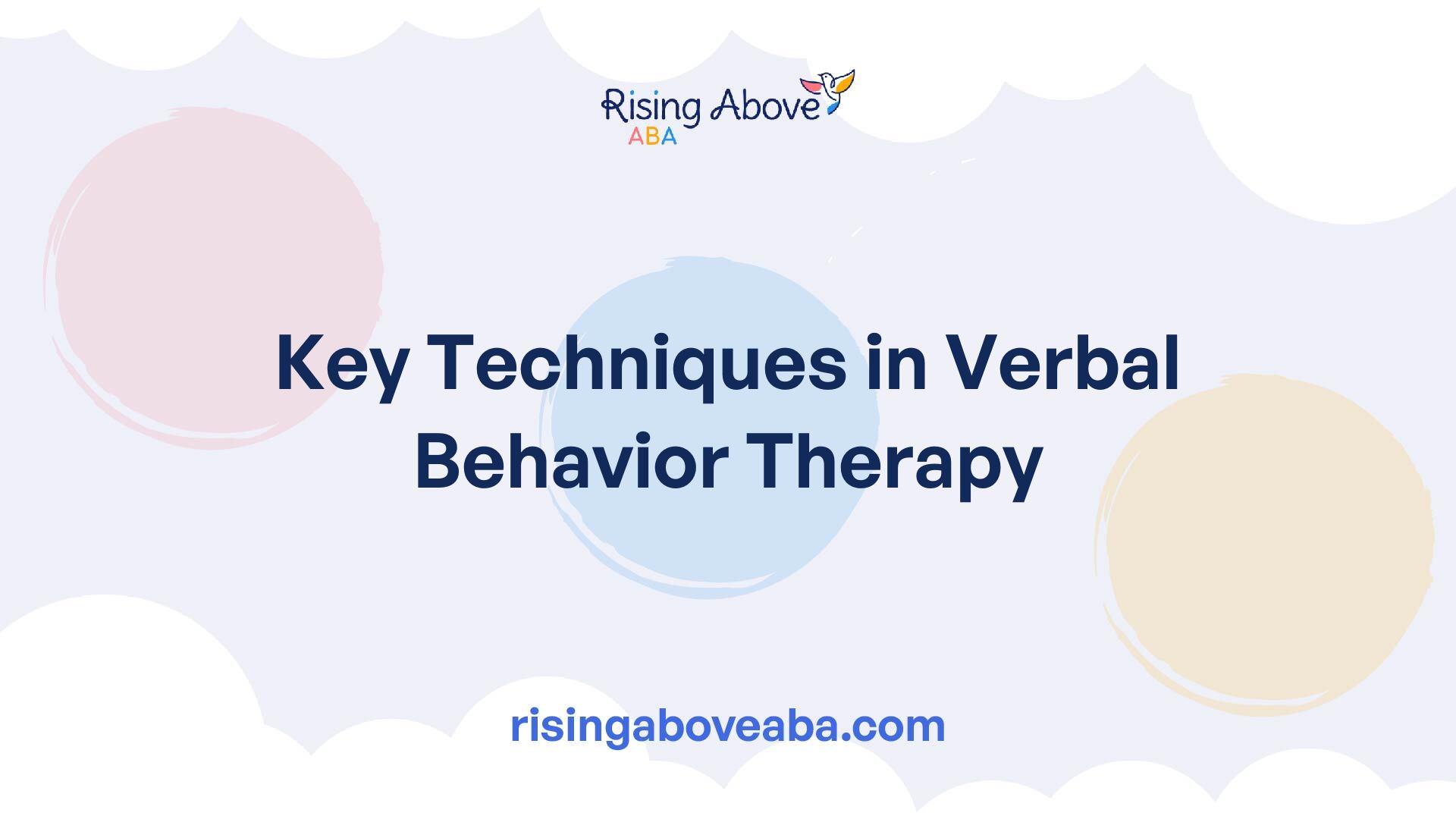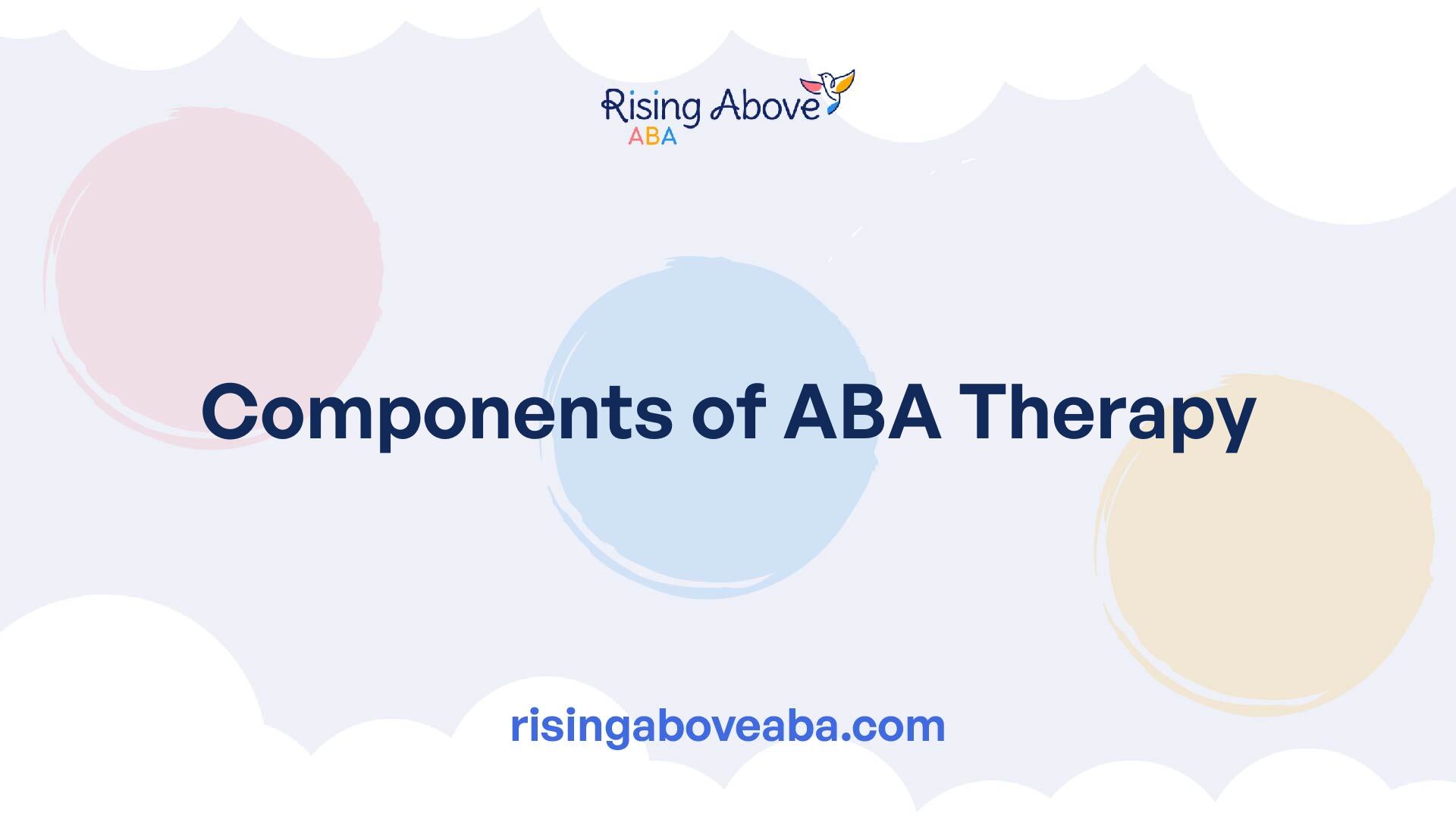Key Techniques in Verbal Behavior Therapy
Unlock the key techniques in verbal behavior therapy. Master communication milestones with proven methods.

Key Techniques in Verbal Behavior Therapy

Exploring Verbal Behavior Therapy involves understanding the techniques that play a critical role in promoting effective communication skills, particularly for individuals with autism spectrum disorder. Integral to the success of Verbal Behavior Therapy (VBT) is the emphasis on positive reinforcement as a primary strategy to reinforce desirable behaviors and foster language development.
Understanding Verbal Behavior Therapy
Verbal Behavior Therapy (VBT) is a specialized form of Applied Behavior Analysis (ABA) that focuses on the principles of behavior to teach language and communication skills to individuals, particularly those on the autism spectrum. Central to VBT is the concept that language is learned behavior and can be developed through targeted interventions and reinforcement strategies.
Through structured interventions and systematic teaching methods, individuals in VBT programs learn to associate words or phrases with their intended meanings, enabling them to effectively express their needs and desires. By incorporating reinforcement principles, VBT aims to motivate individuals to engage in verbal behaviors and improve their communication abilities.
Importance of Positive Reinforcement
In the realm of ABA therapy, positive reinforcement stands out as a cornerstone technique for shaping and maintaining desired behaviors. Individuals undergoing Verbal Behavior Therapy are rewarded with meaningful incentives each time they successfully demonstrate a targeted verbal behavior. This positive reinforcement mechanism is crucial in encouraging individuals to repeat the desired behaviors, gradually strengthening their communication skills over time [1].
Positive reinforcement plays a vital role in the acquisition and maintenance of verbal behaviors within the context of VBT. By offering rewards such as praise, access to preferred items, or social interaction, individuals are motivated to engage in verbal activities and improve their communication proficiency. This approach not only reinforces specific language responses but also fosters a positive learning environment that supports long-term progress and skill retention.
The strategic application of positive reinforcement in VBT contributes to the development and refinement of language skills, enabling individuals to effectively express themselves and engage in meaningful communication interactions. By leveraging the power of positive reinforcement, VBT practitioners can enhance the verbal repertoires of individuals and promote their overall communication success.
Components of ABA Therapy

In the realm of Verbal Behavior Therapy, ABA therapy plays a significant role in fostering positive behavioral changes, particularly in individuals with autism. Two key components of ABA therapy that are instrumental in achieving successful outcomes are ABA Programs Customization and Embracing Positive Reinforcement.
ABA Programs Customization
A crucial aspect of ABA therapy, as highlighted by Autism Speaks, is the customization of ABA programs by qualified behavior analysts, often Board Certified Behavior Analysts (BCBAs). These professionals tailor the ABA programs to suit the unique needs of each individual learner. The goals within these programs are carefully crafted based on various factors, including the individual's age, ability level, existing skills, specific requirements, personal interests, preferences, and family dynamics. This personalized approach ensures that the ABA intervention is targeted and effective, focusing on the specific areas that require improvement for the individual's development.
Embracing Positive Reinforcement
Positive reinforcement is a fundamental strategy within ABA therapy, particularly in the context of verbal behavior therapy. This approach involves providing meaningful rewards to individuals each time they demonstrate a desired behavior successfully. By associating positive outcomes with specific actions, positive reinforcement motivates individuals to repeat those behaviors, leading to long-term positive changes in behavior. Implementing positive reinforcement in ABA therapy fosters a supportive and encouraging environment that promotes skill acquisition, behavior modification, and social interaction among individuals with autism. This approach aims to enhance independence, increase adaptive behaviors, and facilitate successful social interactions for individuals undergoing ABA therapy.
By customizing ABA programs to meet individual needs and embracing the power of positive reinforcement, ABA therapists can create tailored interventions that effectively support individuals in developing essential skills, overcoming challenges, and achieving meaningful progress in their behavioral and communicative abilities. These components form the foundation of successful ABA therapy programs, contributing to the overall growth and well-being of individuals receiving therapy.
Integration of Verbal Behavior Therapy
In the realm of Verbal Behavior Therapy, the integration of verbal operants within Applied Behavior Analysis (ABA) therapy plays a pivotal role in enhancing communication and language skills. Verbal behavior therapy, being highly supported within the field of ABA therapy, focuses on the principles of behavior in acquiring and sustaining language skills [2].
Verbal Operants in ABA
Verbal operants are fundamental to Verbal Behavior (VB) therapy, where language is viewed as a learned behavior. These operants serve as the building blocks for effective communication and language development. Experts often recommend incorporating interventions based on verbal operants into ABA programs to facilitate language acquisition [2].
Enhancing Communication Skills
By integrating verbal operants into ABA programs, individuals with autism can significantly improve their communication skills. Interventions focusing on verbal operants, such as tacting and manding, are central to fostering effective language acquisition within ABA programs. This integration aids in building a strong foundation for language development and enhancing overall communication abilities.
The synergy between Verbal Behavior Therapy and ABA therapy underscores the shared goal of promoting meaningful communication and language comprehension. By embracing interventions based on verbal operants within ABA programs, individuals on the autism spectrum can experience significant advancements in their communication abilities, ultimately fostering greater independence and social interaction.
Tailoring Therapy Programs
In the realm of Verbal Behavior Therapy, tailoring therapy programs to meet individual needs is essential for achieving positive outcomes. Each individual undergoing therapy has unique requirements and strengths, and it is crucial to customize the approach to address their specific challenges and goals effectively.
Individual Therapy Needs
A critical aspect of designing successful therapy programs is the customization by a qualified behavior analyst, often a Board-Certified Behavior Analyst (BCBA). ABA programs are personalized to cater to individual learners, considering factors such as age, ability level, skills, needs, interests, preferences, and family dynamics. Goals are formulated based on these considerations to ensure that the therapy is tailored to the individual's distinct requirements [4].
By assessing and understanding the unique needs of each individual, therapists can create targeted interventions that focus on developing necessary skills, improving communication, and enhancing overall quality of life. This personalized approach allows for more effective therapy sessions and cultivates a supportive environment for growth and progress.
The Verbal Behavior Milestones
Tracking progress and development in verbal behavior therapy involves monitoring the achievement of verbal behavior milestones. These milestones serve as benchmarks to evaluate the individual's progress in communication skills and language development.
Through targeted interventions and consistent therapy sessions, individuals can reach significant milestones that indicate improvements in verbal behavior. These milestones may vary depending on the individual's starting point and specific goals but commonly include achievements such as:
Monitoring progress against these milestones allows therapists to assess the effectiveness of the therapy program and make necessary adjustments to optimize outcomes. By recognizing and celebrating the attainment of verbal behavior milestones, individuals, families, and therapists can acknowledge the achievements and advancements in communication skills, fostering motivation and continued progress.
In the journey of Verbal Behavior Therapy, recognizing individual therapy needs and focusing on the milestones of progress are foundational elements in creating tailored and effective therapy programs that support the development of vital communication skills and enhance overall quality of life.
Techniques in Verbal Behavior Therapy
Verbal Behavior Therapy employs specific techniques tailored to individual needs to effectively improve language skills and communication. Two key techniques within Verbal Behavior Therapy are Discrete Trial Training (DTT) and Natural Environment Teaching (NET).
Discrete Trial Training (DTT)
Discrete Trial Training (DTT) is a structured and intensive teaching method used in Verbal Behavior Therapy to break down complex skills into smaller, more manageable parts. This technique involves presenting a stimulus, prompting a response, and providing positive reinforcement for correct responses. DTT is particularly effective for teaching new skills and promoting behavior change in a controlled setting.
Aspect of DTTDescriptionStimulusPresentation of a specific cue or instructionResponseLearner's reaction or behavior to the stimulusReinforcementPositive feedback or reward for a correct response
DTT is beneficial for individuals with autism as it provides clear directions, immediate feedback, and consistent reinforcement. It is structured, goal-oriented, and allows therapists to target specific skills systematically.
Natural Environment Teaching (NET)
Natural Environment Teaching (NET) is a more naturalistic approach to Verbal Behavior Therapy, focusing on teaching language and communication skills within the individual's everyday environment. This technique emphasizes learning through everyday activities and interactions, making the learning experience more practical and functional.
Key Aspects of NETDetailsIncorporationIntegration of targeted skills into daily routinesContextTeaching in spontaneous, real-life situationsMotivationUtilizing the learner's interests and preferences for engagement
NET encourages active participation and communication in real-world settings, promoting generalization of skills beyond therapy sessions. By incorporating language skills into natural contexts, individuals can better transfer and apply what they have learned to their daily lives.
By incorporating both DTT and NET techniques in Verbal Behavior Therapy sessions, therapists can provide comprehensive and individualized support to enhance language development, communication abilities, and overall quality of life for individuals receiving therapy.
Reinforcement in Therapy
In the realm of Verbal Behavior Therapy, reinforcement techniques play a pivotal role in shaping behaviors and promoting effective communication skills among individuals. Positive reinforcement, in particular, is a fundamental strategy used to encourage and maintain desirable behaviors over time.
Utilizing Positive Reinforcement
Positive reinforcement, as emphasized by Autism Speaks, forms the cornerstone of Applied Behavior Analysis (ABA) therapy. This technique involves rewarding individuals with meaningful incentives each time they exhibit a desired behavior successfully. By linking positive behaviors with rewards, such as praise, access to preferred items, or social interaction, individuals are motivated to continue displaying those behaviors. This reinforcement strategy is instrumental in fostering positive behavior changes and enhancing the learning process.
Moreover, as highlighted by NCBI Bookshelf, the principles of reinforcement and punishment in behavior modification are not based on categorizing behavior as good or bad but rather on increasing or decreasing the likelihood of that behavior occurring. Positive reinforcement focuses on reinforcing behavior through rewards, while negative reinforcement involves removing stimuli to yield positive outcomes.
Strengthening Desired Behaviors
In Verbal Behavior Therapy, reinforcement mechanisms, including positive reinforcement, play a pivotal role in strengthening desired verbal behaviors and promoting effective communication skills. According to Chicago ABA Therapy, incorporating positive reinforcement, such as praise, access to preferred items, or social interaction, helps individuals undergoing therapy to enhance their communication abilities significantly.
By integrating reinforcement principles into therapy sessions, individuals can experience meaningful improvements in their verbal skills and communication efficacy. Positive reinforcement aids in solidifying the association between specific words or phrases and their outcomes. For instance, by linking a word like "chocolate" to the actual item, individuals reinforce the connection between language and its referents, facilitating clearer communication and comprehension.
Overall, the strategic use of positive reinforcement and rewards is essential for reinforcing appropriate behaviors and increasing the likelihood of their recurrence in the future. When individuals receive positive outcomes following the demonstration of desired behaviors, they are motivated to continue engaging in those behaviors, leading to sustained progress in communication development [4].
Challenges in Teaching Communication
When it comes to teaching communication skills within the realm of verbal behavior therapy, there can be various challenges that therapists may face. Overcoming these communication hurdles is essential for effectively helping individuals with developmental disorders progress in their verbal abilities.
Common Difficulties Faced
In the field of Applied Behavior Analysis (ABA) therapy, teachers and therapists may encounter common difficulties while working on improving verbal behavior. Some of these challenges include:
Addressing these common difficulties requires a tailored and patient approach that considers individual needs and learning styles. Therapists need to adapt their techniques to meet the specific challenges faced by each individual.
Overcoming Communication Hurdles
To overcome communication hurdles in verbal behavior therapy, therapists employ various strategies and techniques tailored to the unique needs of each individual. Some effective methods for addressing communication challenges include:
By acknowledging and addressing the common difficulties faced in teaching communication, therapists can develop effective strategies to support individuals with developmental disorders in enhancing their verbal abilities. Through persistent effort and individualized interventions, communication hurdles can be overcome, leading to significant progress in verbal behavior therapy.
Progress Monitoring and Adjustments
Monitoring the progress of communication skills is a crucial aspect of verbal behavior therapy. By closely tracking and assessing the development of these skills, therapists can make informed decisions about the effectiveness of the intervention and make necessary adjustments to ensure optimal outcomes.
Monitoring Communication Skills
Effective monitoring of communication skills involves systematic observation and evaluation of the individual's language abilities, social interactions, and overall communication proficiency. This process may include:
By consistently monitoring communication skills, therapists can identify strengths and areas that require further focus, leading to tailored interventions that address the individual's unique needs.
Adapting Interventions for Success
Adapting interventions based on the ongoing progress and challenges observed is essential for achieving successful outcomes in verbal behavior therapy. Strategies for adapting interventions may include:
By remaining flexible and responsive to the individual's progress, therapists can ensure that the therapy remains effective and relevant. This adaptability is key to maximizing the benefits of verbal behavior therapy and fostering meaningful improvements in communication skills over time.
Through diligent progress monitoring and thoughtful adjustments to therapy interventions, individuals undergoing verbal behavior therapy can experience significant strides in their communication abilities, leading to enhanced social interactions, increased self-expression, and improved overall quality of life.
References
[2]:
[3]:
[4]:

Compassion. Communication. Positivity. Professionalism
Give us a call at 888.572.7473 or reach out to our team online to get started—we're looking forward to partnering with your family.
Latest articles






Reach Out to Rising Above ABA

Most commercial insurance accepted
Contact us for any questions regarding coverage or plans – we’ll be happy to provide you with the clear guidance as to your best options.


